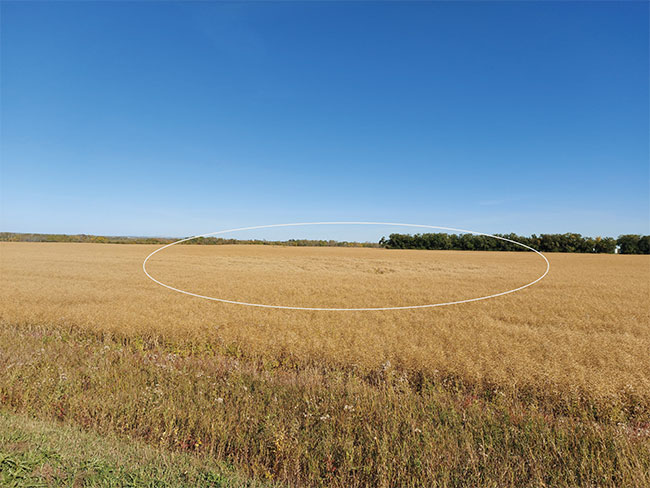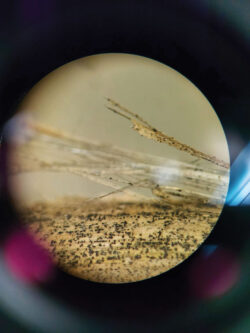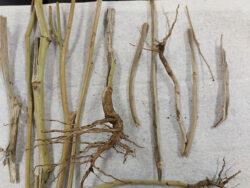
Features
Diseases
Tackling an emerging disease
Progress in understanding and managing verticillium stripe of canola.
July 17, 2023 By Caroline King
 A big multi-disease patch including verticillium stripe disease in a Saskatchewan canola field in 2022.
ALL PhotoS courtesy of Alireza Akhavan, Saskatchewan Ministry of Agriculture.
A big multi-disease patch including verticillium stripe disease in a Saskatchewan canola field in 2022.
ALL PhotoS courtesy of Alireza Akhavan, Saskatchewan Ministry of Agriculture. Since verticillium stripe was first identified in a Manitoba canola field in 2014, a flurry of studies have been launched to learn more about this emerging disease and develop ways to control it. Two examples of these efforts are an expanded disease survey in Saskatchewan to get a better handle on the disease’s occurrence and Hossein Borhan’s research on verticillium resistance in canola.
“Verticillium stripe is a very well-established disease in Europe. Canola yield losses there are reported to range from 10 to 50 per cent, with earlier infection causing more loss. In most cases, the losses are 10 to 15 per cent,” notes Alireza Akhavan, the provincial plant disease specialist with the Saskatchewan Ministry of Agriculture.
“Canadian researchers are in the process of determining how much of a threat this disease might present to Prairie canola production. Those 10 to 50 per cent yield losses may apply to us as well, but we’ll see what the Canadian researchers can tell us in a year or two.”
About the pathogen
Verticillium stripe is caused by Verticillium longisporum, a fungal pathogen. Akhavan explains that the pathogen’s life cycle starts with the germination of its microsclerotia, which are tiny, dark survival structures that can persist in the soil for many years.
Root exudates from a host plant stimulate the microsclerotia to germinate. Then, the fungus develops fungal threads called hyphae that grow toward the root. “The hyphae enter the plant’s vascular system and grow in the xylem. The spores are produced there,” says Akhaven. “They move up in the plant’s vascular system and inhibit the movement of nutrients and water. Eventually, the xylem turns black and collapses.”
“As the plant matures, the pathogen moves from the xylem into the surrounding stem tissues. The microsclerotia develops beneath the epidermis, or skin, of the stem. Then, the epidermis shreds and peels back, exposing many very small, dark, pepper-like microsclerotia.”
These microsclerotia can stay on the stubble or fall into the soil. The pathogen is spread from field to field by the movement of infested soil or stubble via field equipment, water or wind. Disease development is favoured by hot and dry conditions, especially if those conditions occur before flowering.
“The most indicative symptom of verticillium stripe is the small microsclerotia beneath the stem’s epidermis,” says Akhavan. “Scouting for these microsclerotia is best done during or shortly after harvest. Producers need to use a good magnifier to see the microsclerotia because they are so small; they are much smaller than the pycnidia of blackleg.”
During the growing season, producers can look for various symptoms that might indicate verticillium stripe, such as: yellowing leaves; early ripening; stunting; a yellow or brown stripe up one side of the stem while the other side looks green and healthy; and a diffuse greyish discoloration of the base cross-section of a canola stem (whereas blackleg is indicated by a black wedge-shaped discoloration in the cross-section). If producers suspect verticillium stripe based on these types of symptoms, they can send samples to a lab that provides verticillium testing for confirmation.
In addition to canola (Brassica napus), Verticillium longisporum can infect other brassicas such as cauliflower, broccoli and wild mustard. The pathogen is closely related to Verticillium dahliae, which attacks a wide range of plants including crops like potato, tomato, sunflower and brassica crops.
“Verticillium longisporum is more pathogenic on brassica hosts than Verticillium dahliae,” notes Akhavan.
Research indicates that Verticillium longisporum is a hybrid of different Verticillium species, with several hybridization events occurring independently at different times, among different parental lines. Those parental lines include a Verticillium dahliae lineage called D2, another Verticillium dahliae lineage called D3 and two unknown Verticillium species called Species A1 and Species D1.
At least three Verticillium longisporum lineages exist: A1/D1, A1/D2 and A1/D3. Some research indicates these lineages may have differences in virulence, with A1/D1 being the most virulent on canola.
Occurrence on the Prairies
After the 2014 detection in Manitoba, the Canadian Food Inspection Agency (CFIA) conducted follow-up soil sampling for Verticillium longisporum in 2015. Most fields testing positive for the pathogen’s DNA were in the Prairie provinces, but a few were in Ontario, Quebec and British Columbia.

The most indicative symptom of verticillium stripe is development of many small microsclerotia beneath the stem’s epidermis, which are easier to see after harvest with a magnifier.
These days, all three Prairie provinces are on the lookout for verticillium stripe as part of their canola disease surveillance activities.
“In Manitoba, the disease has significantly increased from around 10 per cent prevalence in 2018 to 38 per cent in 2022,” says Akhavan.
“In Alberta, in 2022, the prevalence of verticillium stripe was about two per cent.” However, he points out that the Alberta samples were not confirmed through laboratory tests as being caused by Verticillium longisporum. So, the Alberta situation is still a bit of a question mark.
In 2021, Saskatchewan officially reported the province’s first confirmed cases of verticillium stripe in canola. “During Saskatchewan’s general canola disease survey in 2021, we found four suspicious samples from southeastern Saskatchewan. We submitted them to the University of Manitoba for confirmation. Two samples came back as Verticillium dahliae and one as Verticillium longisporum lineage A1/D3,” says Akhaven.
“Then, after harvest, a producer sent us two more suspicious samples. The University of Manitoba confirmed both samples as Verticillium longisporum, one each of lineage A1/D1 and A1/D2.”
According to Akhavan, the 2021 Saskatchewan reports of A1/D2 and A1/D3 were the first Canadian reports of these two lineages. Before that, only A1/D1 had been reported in Canada.
So, even though Saskatchewan had just six suspicious samples in 2021, those samples were surprisingly diverse.
The occurrence of all three lineages, along with the presence of the pathogen’s DNA in six provinces, suggests to Akhavan that verticillium stripe may have been in Canada for longer than originally thought. “One producer told me he believes he has seen this disease for many years, perhaps up to 10 years, but he just thought that it was blackleg.”
Saskatchewan’s survey results for 2022 were also interesting. During its regular general canola disease survey, which is done in the growing season, no confirmed cases of verticillium stripe were found. However, the province also initiated a small-scale, after-harvest, verticillium stripe-specific survey in eastern Saskatchewan.
“More than 60 per cent of the fields in the verticillium stripe-specific survey had suspected verticillium stripe samples,” says Akhaven. “So, we had quite a sharp difference between the findings of our general canola disease survey and our verticillium-specific survey.”
Given these different results and the rising concerns about verticillium stripe on the Prairies, Saskatchewan is planning to do two province-wide canola disease surveys in 2023.
“One survey will be our regular general canola disease survey during the growing season that looks at all the diseases, including verticillium, and usually samples 200 fields across the province,” explains Akhavan. “Then, for the second survey, we will select 100 of those 200 fields, and we’ll go back to those 100 fields after harvest, in late September or early October, and look specifically for verticillium.”
This approach should provide a clearer picture of how widespread the disease is across Saskatchewan. It could also contribute important information for disease surveillance strategies and for understanding the disease’s potential threat to Prairie canola production.
Managing the disease
Because verticillium stripe is fairly new to Canada, no fungicides are registered to control it and no canola varieties with fully characterized resistance are available to producers at this time.
“Prevention is the best form of management for now,” says Akhavan. Preventative practices include crop rotations with at least a two-year break from canola, sanitizing equipment, minimizing overall soil movement and controlling brassica weeds and canola volunteers.
Akhaven also reminds growers that longer crop rotations are a valuable tool for managing many diseases, not just verticillium stripe. “Wider rotations help break disease cycles and reduce pathogen levels and disease pressure. They also help disease-resistant cultivars to maintain their effectiveness, and they help fungicides to stay effective longer,” he says.
“In general, a four-year canola rotation is recommended. However, a three-year rotation, which is two years away from canola, can be very effective in areas where widening the rotation is a challenge. A two-year rotation may not provide enough time for any effective decline in pathogen populations. And, the worst option is growing canola back-to-back. Also, for all diseases, it is better to avoid seeding canola adjacent to a field that had a heavily infected canola crop in the previous year.”
Finding resistance
Hossein Borhan’s project is contributing to efforts to develop verticillium-resistant canola varieties, which would provide a cost-effective, environmentally friendly tool for managing the disease.
“The most important objective of the project is to identify resistance sources for canola,” says Borhan, a molecular plant pathologist with Agriculture and Agri-Food Canada (AAFC) in Saskatoon. His project also includes work to increase understanding of Verticillium longisporum virulence, how the pathogen interacts with canola plants and to develop molecular tools for identifying the pathogen.
This project, which is just finishing up, was funded by AAFC, Saskatchewan Canola Development Commission, Alberta Canola Producers Commission and Manitoba Canola Growers Association under the Canola Agri-Science Cluster Program. Collaborators on the project include Ralph Lange at InnoTech Alberta and Isobel Parkin with AAFC.
To identify resistance genes, Borhan and his research team started by screening 51 canola lines for resistance to verticillium stripe. They found two lines with a good level of resistance and several lines that were partially resistant to the pathogen, as well as some that were highly susceptible. The highly resistant lines showed no sign of disease, and grew and matured the same as a healthy, uninfected canola plant.
They crossed the most resistant line with a susceptible line to create a population of individual plants. They then tested the response of each plant to infection by Verticillium longisporum. They combined these data with molecular marker data to determine the location of resistance genes on the canola genome.
“We have determined that resistance to Verticillium is multigenic, meaning there are several genes with minor effects, making it more challenging to develop resistant varieties,” says Borhan.
By the end of the project, Borhan’s team will have developed molecular markers to help canola breeders incorporate the identified resistance genes into their commercial cultivars.
More tools
One of the other components of Borhan’s project was to sequence Verticillium longisporum’s genome and identify the genes that exist in its genome. “To learn how Verticillium infects and overcomes canola’s defence, knowledge of the genes and genome sequence is essential. Therefore, we generated the genome sequence of the Verticillium longisporum isolate first identified by CFIA in Manitoba.”

In 2021, Saskatchewan officially reported the province’s first confirmed cases of verticillium stripe with typical symptoms and pathogen signs (microsclerotia).
Borhan and his team have also developed markers for identifying Verticillium longisporum. Testing labs can use these markers to quickly and reliably detect the fungus in soil or plant tissue samples so canola growers can find out if they have this pathogen in their field.
Another component of the project involves investigating canola-Verticillium interactions at the molecular level. “When a pathogen infects a plant, significant changes occur in the level of expression of many genes in both the plant and the pathogen. Gaining knowledge about these changes is important for developing resistant varieties and also for developing tools, such as biological and chemical fungicides,” Borhan explains.
By looking at the plant and pathogen genes that are highly expressed or suppressed during infection, Borhan’s team aims to gain insights into the plant’s defences and the pathogen’s process of infecting the host.
“We are currently analyzing the data we have generated to find out what key plant defence genes are induced during a resistance response to the pathogen and how we could use those genes to boost canola’s resistance against verticillium,” he says.
Looking ahead
“I think the most important benefit of our project will be to incorporate the resistance genes we have identified into canola. From the surveys over the past couple of the years, we are seeing the pathogen more frequently, and that is a concern,” says Borhan.
“Because verticillium stripe is a soil-borne disease, farmers have to be really vigilant about the pathogen. Once it is established in a field, it will be very difficult to eradicate the pathogen. Until canola varieties with resistance against verticillium stripe are available, farmers should apply other management tools to minimize the spread of the pathogen.”
Borhan suspects verticillium stripe will spread faster than clubroot, another canola nemesis, which was first identified in an Alberta canola field in 2003. “In clubroot, everything is confined under the soil. But, with verticillium stripe, infested plant debris is on the surface, so the disease could spread more easily.”
Borhan concludes, “Our research and others’ research on verticillium stripe in Canada is in its early stages. Noticeable progress has been made in the rather short period since verticillium was first reported. However, compared to other canola diseases with a long history of research, our understanding of Verticillium longisporum’s impact on canola is limited, and there is still a lot to learn.”